Ainsley Roberson Rusevlyan, DPM
(252) 946-1181Washington, NC
 Fungal nail infections are a common problem that can last for long periods of time and may recur in some individuals. Carefully following the care instructions given to you by your doctor is one of the most important steps to curing this condition. In addition to treatment provided by your doctor, you can also take certain measures at home to help your feet. Wash your feet often and always dry them thoroughly. Keep your nails clean, dry, and neatly trimmed. Since fungi thrive in warm, moist environments, it is important to change out your socks and shoes frequently, especially if you sweat a lot. Avoid walking barefoot in public places, and don’t share personal items, such as towels or nail clippers, to avoid spreading the fungus. For more information about toenail fungus treatment and prevention strategies, consult with a podiatrist.
Fungal nail infections are a common problem that can last for long periods of time and may recur in some individuals. Carefully following the care instructions given to you by your doctor is one of the most important steps to curing this condition. In addition to treatment provided by your doctor, you can also take certain measures at home to help your feet. Wash your feet often and always dry them thoroughly. Keep your nails clean, dry, and neatly trimmed. Since fungi thrive in warm, moist environments, it is important to change out your socks and shoes frequently, especially if you sweat a lot. Avoid walking barefoot in public places, and don’t share personal items, such as towels or nail clippers, to avoid spreading the fungus. For more information about toenail fungus treatment and prevention strategies, consult with a podiatrist.
If left untreated, toenail fungus may spread to other toenails, skin, or even fingernails. If you suspect you have toenail fungus it is important to seek treatment right away. For more information about treatment, contact Ainsley Rusevlyan, DPM of InStride Roberson Footcare. Our doctor can provide the care you need to keep you pain-free and on your feet.
Symptoms
Treatment
If self-care strategies and over-the-counter medications does not help your fungus, your podiatrist may give you a prescription drug instead. Even if you find relief from your toenail fungus symptoms, you may experience a repeat infection in the future.
Prevention
In order to prevent getting toenail fungus in the future, you should always make sure to wash your feet with soap and water. After washing, it is important to dry your feet thoroughly especially in between the toes. When trimming your toenails, be sure to trim straight across instead of in a rounded shape. It is crucial not to cover up discolored nails with nail polish because that will prevent your nail from being able to “breathe”.
In some cases, surgical procedure may be needed to remove the toenail fungus. Consult with your podiatrist about the best treatment options for your case of toenail fungus.
If you have any questions, please feel free to contact our office located in Washington, NC . We offer the newest diagnostic and treatment technologies for all your foot care needs.
Fungal infection of the toenail, or onychomycosis, typically appears as a gradual change in a toenail’s texture and color that involves brittleness and darkening. The fungal infection itself occurs beneath the surface of the nail. Aside from discoloration, other symptoms include the collection of debris beneath the nail plate, white marks on the nail plate, and a foul odor emanating from the nail. If ignored, the infection can spread into other nails and the skin; in severe cases, it can hinder one’s ability to work or walk.
The toenails are particularly vulnerable to contracting infection in moist environments where people are likely to be walking barefoot, such as around swimming pools, public showers, and locker rooms. Fungal infection may also be more likely to occur in nail beds that have been injured, and sufferers of chronic diseases such as diabetes, circulatory problems, or immunodeficiency conditions are particularly prone to developing fungal nails.
Fungal nails can be primarily prevented by practicing proper hygiene and regularly examining the feet and toes. Carefully washing the feet with soap and water and thoroughly drying the feet afterwards are essential. Other tips include wearing shower shoes in public areas, changing shoes and socks daily, keeping toenails clipped at a short length, wearing breathable shoes that fit properly, wearing moisture-wicking socks, and disinfecting home pedicure tools and instruments used to cut nails.
Fungal nail treatment may vary between patients and the severity of the condition. Your podiatrist may suggest a daily routine of cleansing that spans over a period of time to ease mild infections. Over-the-counter or prescription antifungal agents may also be prescribed, including topical and/or oral medications. Debridement, or the removal of diseased nail matter and debris, may also be performed. In more severe cases, surgical treatment may be needed. In some instances, the temporary removal of the fungal nail allows for the direct application of a topical antifungal to the nail bed. In other cases, a chronically painful fungal nail that has not responded to other treatments may be permanently removed; this allows the infection to be cured and avoids the growth of a deformed nail.
 A common fungal skin infection is known as athlete’s foot. Athlete’s foot is contagious, and can be spread by not wearing the proper footwear in places where fungus thrives, such as swimming pools and communal showers. Scaly, itchy rashes between the toes are often a key indicator that you have developed this uncomfortable condition. To help relieve this discomfort, over the counter powders, sprays, ointments, and lotions may be beneficial for your case. Using hydrogen peroxide can also be useful in killing the fungus on the surface of the skin. Making sure your feet are clean and dry is another great first step in preventing the infection from worsening. For a proper diagnosis and advice on which treatment may be best for you, please speak with a podiatrist.
A common fungal skin infection is known as athlete’s foot. Athlete’s foot is contagious, and can be spread by not wearing the proper footwear in places where fungus thrives, such as swimming pools and communal showers. Scaly, itchy rashes between the toes are often a key indicator that you have developed this uncomfortable condition. To help relieve this discomfort, over the counter powders, sprays, ointments, and lotions may be beneficial for your case. Using hydrogen peroxide can also be useful in killing the fungus on the surface of the skin. Making sure your feet are clean and dry is another great first step in preventing the infection from worsening. For a proper diagnosis and advice on which treatment may be best for you, please speak with a podiatrist.
Athlete’s foot is an inconvenient condition that can be easily reduced with the proper treatment. If you have any concerns about your feet and ankles, contact Ainsley Rusevlyan, DPM from InStride Roberson Footcare. Our doctor will treat your foot and ankle needs.
Athlete’s Foot: The Sole Story
Athlete's foot, also known as tinea pedis, can be an extremely contagious foot infection. It is commonly contracted in public changing areas and bathrooms, dormitory style living quarters, around locker rooms and public swimming pools, or anywhere your feet often come into contact with other people.
Solutions to Combat Athlete’s Foot
Athlete’s foot can cause many irritating symptoms such as dry and flaking skin, itching, and redness. Some more severe symptoms can include bleeding and cracked skin, intense itching and burning, and even pain when walking. In the worst cases, Athlete’s foot can cause blistering as well. Speak to your podiatrist for a better understanding of the different causes of Athlete’s foot, as well as help in determining which treatment options are best for you.
If you have any questions please feel free to contact our office located in Washington, NC . We offer the newest diagnostic and treatment technologies for all your foot and ankle needs.
Read more about Athlete’s FootAthlete’s foot, or tinea pedis, is a skin disease caused by a fungal infection. The infection typically occurs between the toes, and the feet are most subject to this disease because shoes best create the warm, dark, and moist environment in which fungus thrives. Other areas that create a similar environment, such as swimming pools, public showers, and locker rooms; can also promote fungi growth.
Symptoms of athlete’s foot include dry skin, itching, scaling, inflammation, and blistering. Sometimes, blisters can evolve into the cracks or breaks in the skin. The exposed tissue can then create pain, swelling, and discharge. The spread of infection can cause itching and burning as well.
While athlete’s foot commonly occurs between the toes, it may also spread to the toenails or soles of the feet. Other parts of the body, such as the groin or underarms, can also become infected if they are touched after the original area of infection is scratched. Aside from physical contact, athlete’s foot can also spread through the contamination of footwear, clothing or bedsheets.
Proper foot hygiene is essential in preventing athlete’s foot. You can prevent the fungus from spreading by frequently washing your feet using soap and water, thoroughly drying the feet between the toes, changing shoes and socks every day to reduce moisture, and ensuring that bathroom and shower floors are disinfected. Other tips include using shower shoes, avoiding walking barefoot in public environments, wearing light and airy shoes, and wearing socks that keep the feet dry.
While treatment for athlete’s foot can involve topical or oral antifungal drugs, mild cases of the infection can be treated by dusting foot powder in shoes and socks. Any treatment used can be supplemented by frequently bathing the feet and drying the toes. If proper foot hygiene and self-care do not ease your case of athlete’s foot, contact your podiatrist. He will determine if the underlying cause of your condition is truly a fungus. If that is the case, a comprehensive treatment plan may be suggested with the inclusion of prescription antifungal medications.
 Burning pain in the joints of the big toe is a common symptom that is often associated with gout. This condition can be caused by excess uric acid in the blood levels and crystals can form in the joints. This can lead to severe pain and discomfort, and walking may be difficult. Some of the reasons gout may develop can come from genetic factors, obesity, and eating foods that have high levels of purines. These can include shellfish, red meat, and drinks that are made with large amounts of sugar. Patients who are afflicted with gout may find relief when healthy eating habits are implemented, and it can be beneficial to follow a simple exercise program. People who have gout are strongly advised to be under the care of a podiatrist who can effectively treat this condition.
Burning pain in the joints of the big toe is a common symptom that is often associated with gout. This condition can be caused by excess uric acid in the blood levels and crystals can form in the joints. This can lead to severe pain and discomfort, and walking may be difficult. Some of the reasons gout may develop can come from genetic factors, obesity, and eating foods that have high levels of purines. These can include shellfish, red meat, and drinks that are made with large amounts of sugar. Patients who are afflicted with gout may find relief when healthy eating habits are implemented, and it can be beneficial to follow a simple exercise program. People who have gout are strongly advised to be under the care of a podiatrist who can effectively treat this condition.
Gout is a painful condition that can be treated. If you are seeking treatment, contact Ainsley Rusevlyan, DPM from InStride Roberson Footcare. Our doctor will treat your foot and ankle needs.
What Is Gout?
Gout is a form of arthritis that is characterized by sudden, severe attacks of pain, redness, and tenderness in the joints. The condition usually affects the joint at the base of the big toe. A gout attack can occur at any random time, such as the middle of the night while you are asleep.
Symptoms
Risk Factors
Prior to visiting your podiatrist to receive treatment for gout, there are a few things you should do beforehand. If you have gout you should write down your symptoms--including when they started and how often you experience them, important medical information you may have, and any questions you may have. Writing down these three things will help your podiatrist in assessing your specific situation so that he or she may provide the best route of treatment for you.
If you have any questions, please feel free to contact our office located in Washington, NC . We offer the newest diagnostic and treatment technologies for all your foot care needs.
Gout is a form of arthritis that is caused by a buildup of uric acid crystals in the joints. This considered to be one of the most frequently recorded medical illnesses throughout history. Gout occurrences in the US have risen within the past twenty years and the condition now affects 8.3 million people which is 4% of all Americans. Researchers have found that gout affects men more than women and African-American men more than white men.
Symptoms of gout are warmth, swelling, discoloration, and tenderness in the affected joint area. The small joint on the big toe is the most common place for a gout attack to occur.
People who are obese, gain weight excessively, drink alcohol heavily, have high blood pressure, or have abnormal kidney function are more likely to develop gout. Furthermore, certain drugs and diseases are likely to increase levels of uric acid in the joints which eventually leads to gout. You are also more likely to develop gout if you eat a lot of meat and fish.
Many who experience gout attacks will experience repeated attacks over the years. Some people who have gout symptoms, may never have them again, but others may experience them several times a year. If you have gout symptoms throughout the year, you may have recurrent gout. Those who have gout should also be careful about their urate crystals collecting in their urinary tract, because this may lead to kidney stones.
Diagnosis for gout is done by checking the level of uric acid in the joints and blood. Your podiatrist may also prescribe medicine to reduce uric acid buildup in the blood, which will help prevent any gout attacks.
To treat gout, your podiatrist may also prescribe you Anti-inflammatory medication (NSAIDs) which will relieve the pain and swelling of a gout episode and it can also shorten a gout attack. Maintaining a healthy diet is also a proven method to prevent gout attacks.
 Ankle sprains are injuries to the ligaments that support the ankle, and are quite common among athletes. When you sprain your ankle, it is generally recommended that you avoid sports and other strenuous activities that put pressure on the affected ankle. Prior to returning to your typical activities, you will want your ankle sprain to be fully healed. Generally, this means that any swelling has gone down, you can bear weight on the affected ankle without limping, you have a full range of motion, your strength returns to normal, and your ankle is no longer causing you pain. You will also, of course, want to get permission from your doctor to return to your usual activities. For more information about ankle sprains and when to return to your normal routines, consult with a podiatrist.
Ankle sprains are injuries to the ligaments that support the ankle, and are quite common among athletes. When you sprain your ankle, it is generally recommended that you avoid sports and other strenuous activities that put pressure on the affected ankle. Prior to returning to your typical activities, you will want your ankle sprain to be fully healed. Generally, this means that any swelling has gone down, you can bear weight on the affected ankle without limping, you have a full range of motion, your strength returns to normal, and your ankle is no longer causing you pain. You will also, of course, want to get permission from your doctor to return to your usual activities. For more information about ankle sprains and when to return to your normal routines, consult with a podiatrist.
Ankle sprains are common but need immediate attention. If you need your feet checked, contact Ainsley Rusevlyan, DPM from InStride Roberson Footcare. Our doctor can provide the care you need to keep you pain-free and on your feet.
How Does an Ankle Sprain Occur?
Ankle sprains take place when the ligaments in your ankle are torn or stretched beyond their limits. There are multiple ways that the ankle can become injured, including twisting or rolling over onto your ankle, putting undue stress on it, or causing trauma to the ankle itself.
What Are the Symptoms?
Preventing a Sprain
Treatment of a Sprain
Treatment of a sprain depends on the severity. Many times, people are told to rest and remain off their feet completely, while others are given an air cast. If the sprain is very severe, surgery may be required.
If you have suffered an ankle sprain previously, you may want to consider additional support such as a brace and regular exercises to strengthen the ankle.
If you have any questions please feel free to contact our office located in Washington, NC . We offer the newest diagnostic and treatment technologies for all your foot and ankle needs.
Ankle sprains occur when ligaments that support the ankle stretch beyond their limits and tear. These types of injuries are very common and can occur in people of all ages. Sprains may range from mild to severe, depending on how much damage is done to the ligaments. If a sprain goes untreated, a more severe sprain may occur which can further damage the ankle. Repeated ankle sprains can lead to chronic ankle pain.
There are some risk factors that can increase your risk of suffering a sprained ankle. Those who participate in sports, walk on uneven surfaces, have a prior ankle injury, are in poor physical condition, or wear improper shoes are more likely to get a sprained ankle.
There are a few symptoms to look out for if you suspect you are suffering from a sprained ankle. Some common symptoms are swelling, bruising, tenderness, and instability of the ankle. In cases where the tearing of the ligaments is severe, there may be a “popping” sound when the strain occurs.
The RICE method is proven to be effective in treating ankle sprains. RICE stands for Rest, Ice, Compression, and Elevation. Rest is important for treatment especially within the first 24 to 48 hours. You should also ice your sprained ankle for the first 48 hours for 20 minutes at a time. A small piece of cloth should be placed between the ice and the affected area. For the compression step, you should wear a brace that is snug, but not too tight that it cuts off circulation. When choosing a brace, be sure to choose one that is suitable for the type of ankle sprain you have. Lastly, you should elevate your foot above the heart as often as possible.
After you treat a sprain, you should go through rehabilitation to prevent the injury from occurring again. There are three phases to the rehab process. The first phase involves resting, protecting and reducing the swelling of the injury. The second phase consists of restoring the ankles flexibility, range of motion, and strength. The third phase consists of slowly returning to activity and maintenance exercises.
If you suspect you have an ankle sprain, you shouldn’t hesitate to consult with your podiatrist. Your podiatrist will be able to give you a proper diagnosis and a suitable treatment option for your condition.